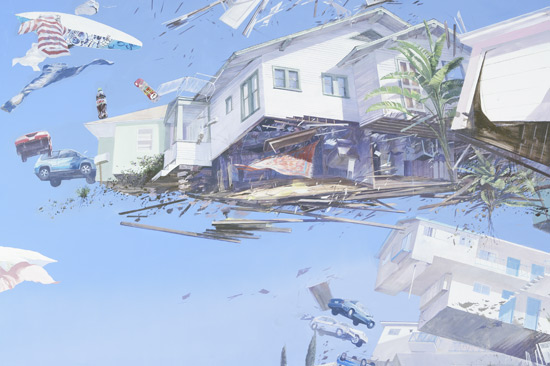Here are three cancer spots:
Skin.
Stomach.
Bone.
You can take your pick, but everyone
Wants skin.
My friend, last night I walked outside
And watched the stars do nothing at all unusual.
Ask anyone:
Describe the stars.
That's exactly how they looked.
And even
If I dressed them up as children,
Gave them wagons, cakes, and birthday boots,
Then broke their fingers one by one until they said
It's only you they shine for,
I know what you'd want:
You'd want more.(Excerpts from James Krusoe's poem "You Want More" in
History of the World)
Type of activitiesIn SL, you don't need to eat, don't need to sleep. There's nothing you need to do. What type of activities would you engage in?
Currently people use SL mainly to manufacture desires and fulfill them. These desires are, mentioned by Philip Rosedale at his talk at SFAI, a big house, a Ferrari, to look like Angelina Jolie or Brad Pitt...
Rather than constructing our identities via commodities and appearance enhancements, why not use SL to explore and model problems in real life to try to solve them? The most fun way to solve problems is collaboratively and SL provides a platform to do so.
Contrary to the belief that if values are left open (undefined) and the architecture and structures are left open (unconstrained), then society (SL) would self-order to be directed towards useful applications, promote innovation, and provide experiences that are exciting, thought-provoking and fulfilling, this is not the case as the main activity in SL is vapid consumerism. If we want certain values, goals, objectives for SL, we have to first define them explicitly, and then build the architecture, structure, and user interfaces to materialize them. (This is an application of
Lessig's proposition for cyberspace to SL.
www.socialtext.net/codev2/index.cgi?code_is_law)
If some of these goals are to encourage widespread participation, to remove language barriers in order to promote communication and understanding in a transnational virtual world, and to explore and understand real world problems rather than consumerist fantasies, then put in the structures to enable them. Currently, these goals have not materialized: only a small portion of people continue to stay in SL after trying it out, providing seamless translations of languages across different countries and cultures is not a priority (even though this is a potential of SL that is stated by Philip Rosedale at his SFAI talk) and translators are not provided by default but need to be purchased. and the main activity in SL is shopping.
EconomyIn
Maneki Neko, a short story by Bruce Sterling, people carry a handheld wireless device similar to the iphone to organize, manage, and communicate work that needs to be done. The network keeps track of the tasks, and the interest and skills of participants, in order to assign the tasks to the appropriate participants. (
tqft.net/wiki/Maneki_Neko)
This is trivial to do in SL. Instead of assigning tasks as in
Maneki Neko, participants pick whatever they want to work on. When a participant enters SL, s/he can open a window to see what tasks need help on, what avatar roles s/he can fill. This solves some of the current problems in SL: feeling purposeless, not having fulfilling experiences, going to a lot of empty places and not finding many people to talk to.
Avatar-roles may include animals, such as sharks, actors in an installation or play (to be described in the
Narrative section) or roles that do not need a body (frees up attention to focus on the task, to be described in the
Representation section). Trainers are on hand to teach participants who are interested in helping with any avatar role. Afterwards, the participant can herself/himself be a trainer.
The aim of peer production and processes is to encourage the most widespread participation. (Michel Bauwens writes about peer production in "
The Political Economy of Peer Production,"
www.ctheory.net/articles.aspx?id=499.)
With immaterial production in the information environment, such as SL,
Yochai Benkler writes that people will “apply behaviors they practice in their living rooms or in the elevators – ‘Here, let me lend you a hand,’ or ‘What did you think of last night’s speech’ – to production problems that had, throughout the twentieth century, been solved on the model of Ford and General Motors. The rise of peer production … is as rational and efficient given the objectives and material conditions of information production at the turn of the twenty-first century as the assembly line was for the conditions at the turn of the twentieth. The pooling of human creativity and of computation, communication, and storage enables nonmarket motivations and relations to play a much larger role in the production of the information environment than it has been able to for at least decades, perhaps for as long as a century and a half.” (
cyber.law.harvard.edu/wealth_of_networks)
Appreciation, reward: Participants send each other thank-you messages which are listed in the profile. Participants also award each other points for useful work, friendly behavior, artistic/original ideas that undermine the status quo. These structures are put in place to encourage and reenforce desired behavior — many online social sites already use this method effectively. They also make the participants feel appreciated for their efforts, an alternative to monetary reward.
A balance has to be struck between showing appreciation and encouraging participants to do a task in order to collect points and build up their status/self image. If this is done successfully, it would build a sense of community and encourage collaboration.
Some services should be paid &mdash services that are in need, that take a lot of effort to accomplish, and require monetary compensation in order to be available. A structure would be set in place to do this. A possible scenario: people who would like monetary payment indicate that in the database, and donations would be directed towards work that have been voted the most useful. People can also donate directly to a particular service, or commission or pay for work, in addition to donating to a general fund.
Research and knowledge productionWhat better place to collaborate and discuss how to solve FL problems in SL, than the social, collaborative environment of SL? This can be done both in SL, and outside on easily accessible web browsers. Discussions may revolve around:
What type of FL problems can be effectively and creatively addressed in SL? (E.g. gender identity and representation is a good match.)
Defining the FL problem — what aspect can be studied and achieved in SL?
Modeling the problem in SL, including communication structures that would be useful for collaboration.



![[AnarchistCastle.jpg]](https://blogger.googleusercontent.com/img/b/R29vZ2xl/AVvXsEhPZJApd7Bl17rR34dCCswEnMXi1wWaqWQzER7b0WlwfTnLr5d9l-mp2Dsa9gTAty6YgapibwyuxADkx4YCHXPOPd63V2nsRvYtsUa4phDJuGryGS5Fb_qH5uL-CulH2ho0ODB7MGsWF1Q/s1600/AnarchistCastle.jpg)










 Image:
Image: 






 Image:
Image: 







